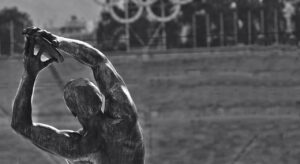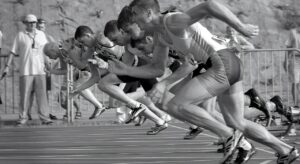Ancient Greek physical culture and sports began to form in the conditions of the collapse of the tribal system and the formation of the slave-owning society during the Cretan-Mycenaean (III-II thousand B.C.) and Homeric (XII-IX centuries B.C.) periods. However, physical culture reached its peak in the eighth- fourth centuries B.C. during the heyday of slave-owning relations. The division of labor between industry and agriculture, the growth of trade led to changes in social relations and cultural life in Greece. Depending on economic, political and cultural development, military organization and the system of education in Greek polis-states, specific tasks, means, forms and methods of physical education were determined. The most typical in this respect were Laconica with its main city Sparta and Attica – Athens, where two different approaches to the tasks of physical education emerged.
Physical Education in Sparta. Laconica was formed in the ninth century B.C. Sparta had a subsistence economy and conducted almost no foreign trade. There were about 9 thousand families of slave-owners (Spartiats), 30 thousand artisans, traders and landowners, 200 thousand slaves (Ilots). The Spartites, as the ruling class, fearing slave rebellions and waging numerous wars, created a harsh system of upbringing. Until the age of 7, children were brought up in a family. Even at that age, children were toughened up, taught not to be afraid of the dark, not to cry, not to be picky about food. From the age of 7 to 18, young Spartites were kept in state institutions, where they were mostly engaged in physical exercises. They were subjected to harsh trials, taught to endure cold, hunger, thirst and pain. An important place in the education of young men was occupied by exercises in javelin and discus throwing, running and wrestling, jumping, as well as war games, hunting wild animals. Not much attention was paid to mental education. Classes were held in singing choral songs, music, and dancing. The leaders (pedonomes) of young Spartites, appointed by the state, paid special attention to the education of courage and ingenuity, martial warlike character, contempt for slaves, the ability to conduct hand-to-hand combat and mercilessly kill opponents. To this end, night raids on slaves, called cryptias, were organized.
Young men of 18-20 years old were enrolled in groups of ephebians, where they continued their physical and military training. They were then classified as warriors, and were obliged to perform military service until their old age.
In Sparta great attention was paid to the physical education of girls. According to the descriptions of the ancient writers Xenophon, Pausanias and Plutarch, girls had to run, wrestle, throw discus and spear to strengthen their bodies, so that their future children were born and grew up healthy. They were forbidden to lead a pampered life. It was not uncommon for armed Spartan women to carry guards on an equal footing with men. The Spartan state educational system and military organization created one of the strongest armies in Greece, which for a long time was invincible. Spartan athletes participated in many Olympic, Pythian, and other games and were often victorious.
Athens. Physical education was carried out differently in Attica. In the V-IV centuries BC Athens was a typical slave-owning republic with a distinct class stratification of the society. The rapid development of trade and commerce, culture and science made Athens the center of all Greek social life. Every free citizen had the right to be active in public life. The educational and upbringing systems in this society extended to full wealthy Athenian citizens. They were not confined to the military and physical training of youth, as in Sparta, but gave a varied education. The Athenians believed that the harmonious development of man should consist of mental, moral, and social well-being.
Much attention was paid to games at this age. Then boys were sent to school, while girls continued to be educated at home. From the age of 7 to 16 boys attended public and private school. They were educated in mucic (from the word “muse” – the goddess patroness of science and art; mucic school gave mental education in close connection with the moral and aesthetic) and gymnastic schools (from the word “gymnos” – naked, the Greeks did physical exercises without clothes).
The gymnastic school, called palestra (from the word “pale” – wrestling), was attended by adolescents from the age of 12-14. From the age of 14 the musical school took second place, and the gymnastic school came first.
At the age of 16, young men of wealthy parents entered the gymnasium after completing their studies at the mousy and gymnasium schools. In Athens there were three gymnasiums maintained at public expense: The Academy, the Lycée, and the Kyiosargus. In the Gymnasium the young Athenians studied politics, philosophy and literature in addition to physical exercise.



